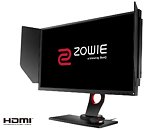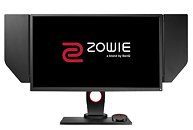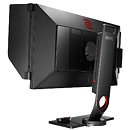Friday, October 20th 2017

BenQ Announces the ZOWIE XL2536 Monitor with DyAc
BenQ rolled out the ZOWIE XL2536 gaming monitor featuring DyAc (Dynamic Accuracy). This 25-inch (24.5-inch viewing area) monitor features Full HD (1920 x 1080 pixels) resolution, but bolstered by 144 Hz refresh-rate, and 1 ms (gray to gray) response-time. The DyAc feature helps keep the screen steady in fast-paced game sequences by compensating for motion-blur from the game. In theory, this should improve your accuracy in first-person shooters that have gun recoil mechanics. There's also an OSD crosshair to help you out with aim. The Black eQualizer feature improves contrast in dark areas of an otherwise bright 3D scene, letting you spot campers hiding in the dark.
Other key specs of the ZOWIE XL2536 include 320 cd/m² maximum brightness, 1,000:1 static, and 12M:1 dynamic contrast ratios. The monitor features a non-PWM method of controlling brightness of its LED back-lighting, making it flicker-free. Display inputs include one each of HDMI 2.0, DisplayPort 1.2, and dual-link DVI-D. Other features include a 2-port USB 3.0 hub, and audio jacks. The stand allows height, tilt, and swivel adjustments. The company didn't reveal pricing.
Other key specs of the ZOWIE XL2536 include 320 cd/m² maximum brightness, 1,000:1 static, and 12M:1 dynamic contrast ratios. The monitor features a non-PWM method of controlling brightness of its LED back-lighting, making it flicker-free. Display inputs include one each of HDMI 2.0, DisplayPort 1.2, and dual-link DVI-D. Other features include a 2-port USB 3.0 hub, and audio jacks. The stand allows height, tilt, and swivel adjustments. The company didn't reveal pricing.



8 Comments on BenQ Announces the ZOWIE XL2536 Monitor with DyAc
It still surprises me how they keep reselling el cheapo TN junk at a premium. And it surprises me even more how people keep buying it.
I have side by side tested TN and VA panels with high refresh rates, and the only advantage of the TN is a very, very slightly less pronounced overdrive, as in, if you aren't at 15cm analyzing the pixels yourself, you won't ever spot a difference. At the same time, if you put these two side by side, the TN looks like a washed out, limited-range RGB panel while the VA is super vibrant without oversaturating anything. IPS is similar in this difference, just a bit less contrast rich.